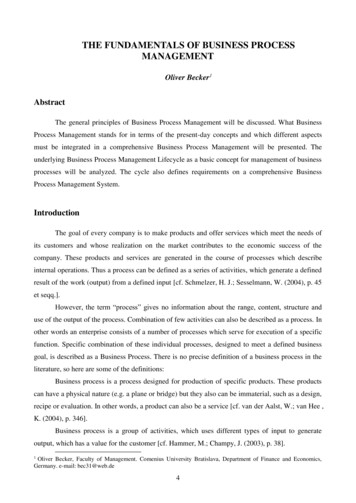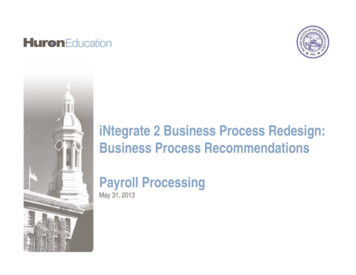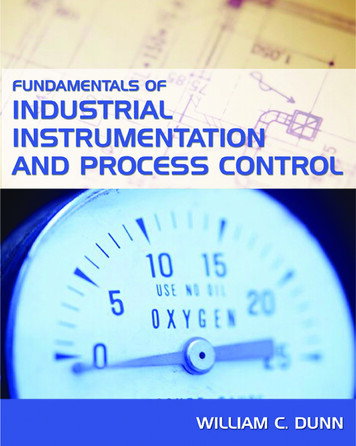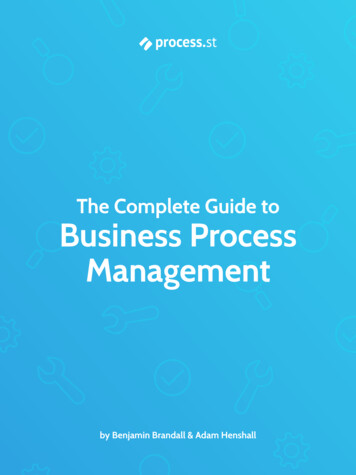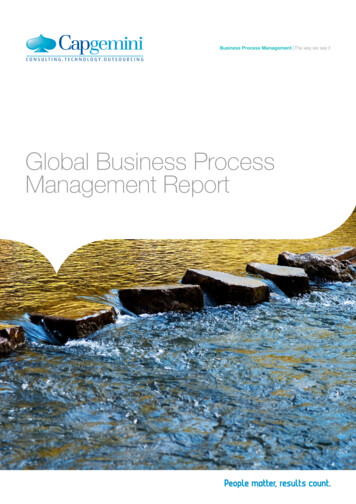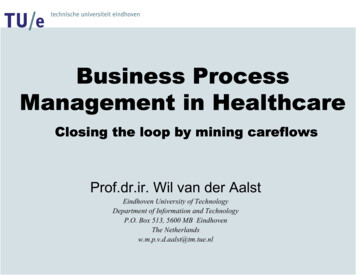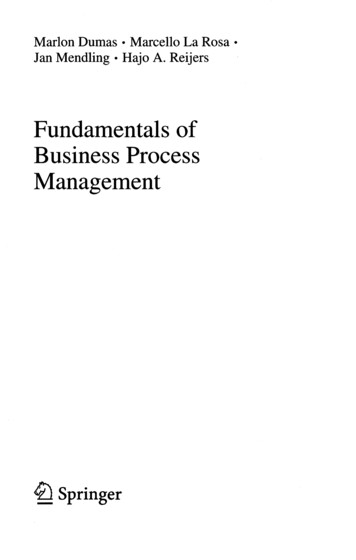
Transcription
Marlon Dumas Marcello La RosaJan Mendling Hajo A. ReijersFundamentals ofBusiness ProcessManagementSpringer
Contents1Introduction to Business Process Management1.1 Processes Everywhere1.2 Ingredients of a Business Process1.3 Origins and History of BPM1.3.1 The Functional Organization1.3.2 The Birth of Process Thinking1.3.3 The Rise and Fall of BPR1.4 The BPM Lifecycle1.5 Recap1.6 Solutions to Exercises1.7 Further Exercises1.8 Further Reading11388101215262628312Process Identification2.1 Focusing on Key Processes2.1.1 The Designation Phase2.1.2 The Evaluation Phase2.2 Designing a Process Architecture2.2.1 Identify Case Types2.2.2 Identify Functions for Case Types2.2.3 Construct Case/Function Matrices2.2.4 Identify Processes2.2.5 Complete the Process Architecture2.3 Recap2.4 Solutions to Exercises2.5 Further Exercises2.6 Further Reading33333438424445495055575759603Essential Process Modeling3.1 First Steps with BPMN3.2 Branching and Merging3.2.1 Exclusive Decisions63636767xiii
xivContents3.33.43.53.63.73.83.2.2 Parallel Execution3.2.3 Inclusive Decisions3.2.4 Rework and RepetitionInformation ArtifactsResourcesRecapSolutions to ExercisesFurther ExercisesFurther Reading6972777982898993954Advanced Process Modeling4.1 Process Decomposition4.2 Process Reuse4.3 More on Rework and Repetition4.3.1 Parallel Repetition4.3.2 Uncontrolled Repetition4.4 Handling Events4.4.1 Message Events4.4.2 Temporal Events4.4.3 Racing Events4.5 Handling Exceptions4.5.1 Process Abortion4.5.2 Internal Exceptions4.5.3 External Exceptions4.5.4 Activity Timeouts4.5.5 Non-interrupting Events and Complex Exceptions4.5.6 Interlude: Event Sub-processes4.5.7 Activity Compensation4.6 Processes and Business Rules4.7 Process Choreographies4.8 Recap4.9 Solutions to Exercises4.10 Further Exercises4.11 Further 1191211221241251291301461525Process Discovery5.1 The Setting of Process Discovery5.1.1 Process Analyst Versus Domain Expert5.1.2 Three Process Discovery Challenges5.1.3 Profile of a Process Analyst5.2 Discovery Methods5.2.1 Evidence-Based Discovery5.2.2 Interview-Based Discovery5.2.3 Workshop-Based Discovery5.2.4 Strengths and Limitations155155156158159161161162164165
Contents5.35.45.55.65.75.8xvProcess Modeling Method5.3.1 Identify the Process Boundaries5.3.2 Identify Activities and Events5.3.3 Identify Resources and Their Handovers5.3.4 Identify the Control Flow5.3.5 Identify Additional ElementsProcess Model Quality Assurance5.4.1 Syntactic Quality and Verification5.4.2 Semantic Quality and Validation5.4.3 Pragmatic Quality and Certification5.4.4 Modeling Guidelines and ConventionsRecapSolutions to ExercisesFurther ExercisesFurther 836Qualitative Process Analysis6.1 Value-Added Analysis6.1.1 Value Classification6.1.2 Waste Elimination6.2 Root Cause Analysis6.2.1 Cause-Effect Diagrams6.2.2 Why-Why Diagrams6.3 Issue Documentation and Impact Assessment6.3.1 Issue Register6.3.2 Pareto Analysis and PICK Charts6.4 Recap6.5 Solutions to Exercises6.6 Further Exercises6.7 Further Quantitative Process Analysis2137.1 Performance Measures2137.1.1 Process Performance Dimensions2137.1.2 Balanced Scorecard2177.1.3 Reference Models and Industry Benchmarks2187.2 Flow Analysis2197.2.1 Calculating Cycle Time Using Flow Analysis2197.2.2 Cycle Time Efficiency2247.2.3 Cycle Time and Work-In-Process2257.2.4 Other Applications and Limitations of Flow Analysis . . . 2277.3 Queues2297.3.1 Basics of Queueing Theory2297.3.2 M/M/l and M/M/c Models2327.3.3 Limitations of Basic Queueing Theory234
Contents7.47.57.67.77.8Simulation7.4.1 Anatomy of a Process Simulation7.4.2 Input for Process Simulation7.4.3 Simulation Tools7.4.4 A Word of CautionRecapSolutions to ExercisesFurther ExercisesFurther Reading235235236240243243244246250Process Redesign2538.1 The Essence of Process Redesign2538.1.1 Why Redesign?2538.1.2 What Is Redesign?2568.1.3 The Devil's Quadrangle2588.1.4 How to Redesign?2598.2 Heuristic Process Redesign2628.2.1 Customer Heuristics2638.2.2 Business Process Operation Heuristics2648.2.3 Business Process Behavior Heuristics2668.2.4 Organization Heuristics2678.2.5 Information Heuristics2708.2.6 Technology Heuristics2718.2.7 External Environment Heuristics2718.3 The Case of a Health Care Institution2738.3.1 Sending Medical Files by Post2758.3.2 Periodic Meetings2758.3.3 Requesting Medical Files2768.4 Product-Based Design2788.4.1 Analysis: Creating a Product Data Model2798.4.2 Design: Deriving a Process from a Product Data Model . . 2858.5 Recap2888.6 Solutions to Exercises2898.7 Further Exercises2928.8 Further Reading295Process Automation9.1 Automating Business Processes9.1.1 Business Process Management Systems9.1.2 Architecture of a BPMS9.1.3 The Case of ACNS9.2 Advantages of Introducing a BPMS9.2.1 Workload Reduction9.2.2 Flexible System Integration9.2.3 Execution Transparency9.2.4 Rule Enforcement297297298299304309309310311312
Contentsxvii9.3Challenges of Introducing a BPMS3139.3.1 Technical Challenges3139.3.2 Organizational Challenges314Turning Process Models Executable3169.4.1 Identify the Automation Boundaries3179.4.2 Review Manual Tasks3199.4.3 Complete the Process Model3239.4.4 Bring the Process Model to an Adequate Granularity Level 3249.4.5 Specify Execution Properties3279.4.6 The Last Mile337Recap338Solutions to Exercises338Further Exercises347Further Reading3519.49.59.69.79.810 Process Intelligence10.1 Process Execution and Event Logs10.1.1 The Perspective of Participants on Process Execution10.1.2 The Perspective of the Process Owner on ProcessExecution10.1.3 Structure of Event Logs10.1.4 Challenges of Extracting Event Logs10.2 Automatic Process Discovery10.2.1 Assumptions of the «-Algorithm10.2.2 The Order Relations of the a-Algorithm10.2.3 The a-Algorithm10.2.4 Robust Process Discovery10.3 Performance Analysis10.3.1 Time Measurement10.3.2 Cost Measurement10.3.3 Quality Measurement10.3.4 Flexibility Measurement10.4 Conformance Checking10.4.1 Conformance of Control Flow10.4.2 Conformance of Data and Resources10.5 Recap10.6 Solutions to Exercises10.7 Further Exercises10.8 Further Reading353353. . . 7378379382382References385Index391
Fundamentals of Business Process Management Springer . Contents 1 Introduction to Business Process Management 1 1.1 Processes Everywhere 1 1.2 Ingredients of a Business Process 3 1.3 Origins and History of BPM 8 1.3.1 The Functional Organization 8 1.3.2 The Birth of Process Thinking 10 1.3.3 The Rise and Fall of BPR 12 1.4 The BPM Lifecycle 15 1.5 Recap 26 1.6 Solutions to Exercises 26 1.7 .
